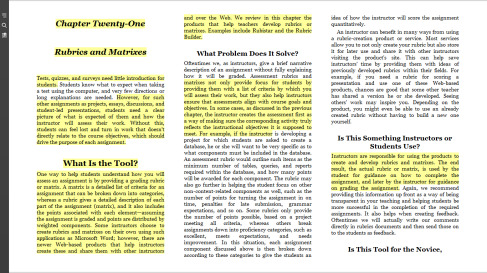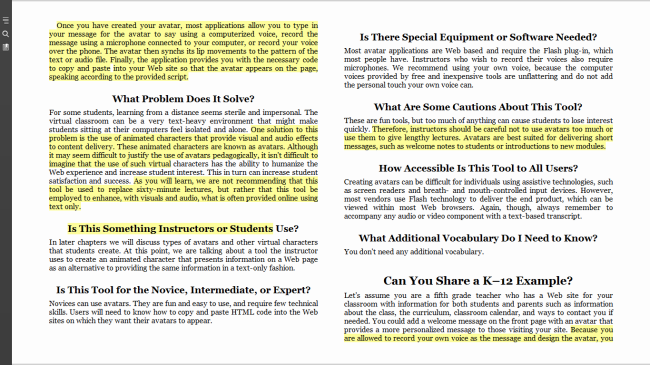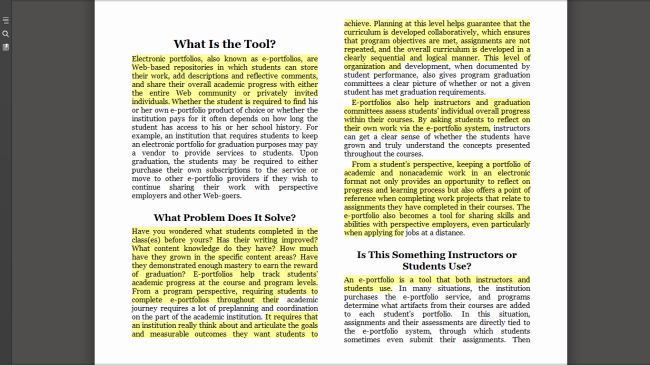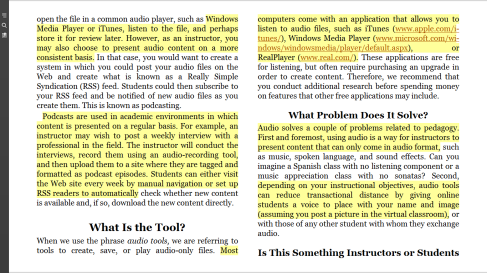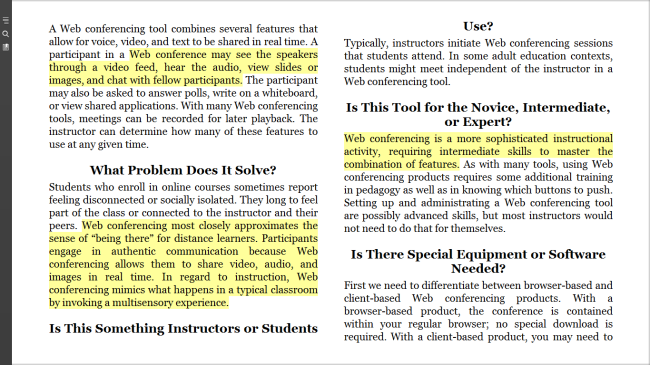Reflection on Tools to Assess Learning
Manning & Johnson (2011) stated that effective tools used to assess leaning relate to course goals, objectives and measure outcomes. Examples of tools to assess student learning are matrices and rubrics. A matrix is a list of criteria for an assignment that may have condensed categories whereas rubrics provide a detailed description of the assignment (matrix), and it includes the points associated with each element. Effective rubrics may help students focus on task and provide clear expectations of course goals and objectives. The instructor may create and describe the rubric and the student is guided on how to complete the assignment. Later, the instructor will use the rubric to grade the assignment. Instructors may choose to create rubrics and matrices on Microsoft Word applications or use newer web-based products to create and share with other instructors over the Web. Examples of web-based products are Rubistar and Rubric Builder.
Manning, Susan; Johnson, Kevin E. (2011). The Technology Toolbelt for Teaching
(Kindle Locations 2275-2434). Wiley. Kindle Edition.
Reflections the E-Reader
As I was reading the chapter on rubrics and matrices, I learned about the features of the e-reader such as the foreign language component. I discovered that I could easily have the English language translated to a foreign language. I would click the mouse over the English word and it would translate the word to German or Chinese language. How awesome is that! The e-reader has global capabilities for the world to use. What a global world we live in with the use of technology using the e-reader!
META-REFLECTION
Manning and Johnson (2011) described the various educational technology tools to assess student learning, present content, and tools to collaborate and communicate. For example, the use of simulation technology in nursing education is an effective teaching strategy. But the simulation process must augment other teaching models.
Knowledge about these various tools empowers me to be an effective nurse educator in my nursing practice and role in teaching. Assessing learning using matrices and rubrics is important in teaching. Learning how to navigate through the process is incredible. Collaboration through the use of YouTube, webcasting, podcasts and the use of e-portfolios in future learning platforms are powerful tools that can be utilized by any future educator.
NETS Standard and NLN standards provide me a reference point and guidelines for implementing effective and safe teaching technology tools. They also lay out a framework for approaching new and emerging technologies (which are all but certain in the future). They may prove especially important for non-digital natives who need to transition into using new software/programs.
TELA Project – “Overview of Occupational Lung Diseases”
TELA Project – “Overview of Occupational Lung Diseases”
Here’s my TELA Project! The link takes you to my YouTube channel where you will find the first of ten video lectures that correspond to Spirometry course that would be taken by nursing and other healthcare professionals. Below is the syllabus I designed for the course.
NIOSH-Approved Spirometry Course
August 12-14, 2013
Course Number: 22005
Course Title: NIOSH-Approved Spirometry Course 2013
Dates, Time, and Place: August 12-15, 7:30 AM-4:00 PM
Quarter/Year: Summer 2013
Faculty: Maria P. Sugui, COHN-S, RN, Occupational Health and Preventive Medicine
Course Description:
The NIOSH approved Spirometry Course is designed to train health professionals to perform pulmonary function testing in an occupational health setting. The student will learn how to analyze normal and abnormal spirometry tracings, use of the volume and flow spirometers, performing quality control testing as outlined by American Thoracic Society Standards, describe back extrapolation, and analyze pulmonary tracings for various lung conditions. Students will receive a certificate and 19 CEU’s upon successful completion of course.
Course Calendar:
The following are standards from the NETS Standard for Teachers created by ISTE and will be met upon completion of the course:
http://www.iste.org/docs/pdfs/nets-t-standards.pdf?sfvrsn=2
According to the NETS Standards for Teachers:
Standard 1.C.
Facilitate student learning and creativity by promoting student reflection using collaborative
tools to reveal and clarify students’ conceptual understanding and thinking, planning, and
creative processes. The course requires students to approach traditional lecture material through the use of YouTube. Reflection and collaboration is encouraged. Students will be required to communicate and discuss the lecture in the comment section of the instructor’s YouTube channel.
Standard 3.A.
Model digital age work and learning. Students will demonstrate fluency in technology systems and the transfer of current knowledge to new technologies and situations. The course requires students to familiarize themselves with a Flow Spirometer. Students will be expected to conduct pulmonary function testing and calibration. Also, students will be required to analyze and evaluate data provided by the Hankinson Computer Simulation Module. Basic understanding and correct interpretation of graphical data output from laptop set-up will be a minimum requirement for all students.
Standard 4.C.
Promote and model digital citizenship and responsibility. Students will be expected to promote and model digital etiquette and responsible social interactions related to the use of technology and information. Student engagement will primarily be conducted through YouTube where respectful commentary and interaction among fellow students and between student and instructor will be expected.
According to the National League for Nursing (NLN) 2005 Core Competencies for Nurse Educators Standards
Competency 1:
Facilitate Learning:
“Nurse Educators are responsible for creating an environment in classroom, laboratory, and clinical settings that facilitates student learning and achievement of desired cognitive, affective, and psychomotor outcomes and using innovative technology skillfully to promote the teaching-learning process
Competency 2
Facilitate Learner development and Socialization:
“Nurse Educators recognize their responsibility for helping students develop as nurses and integrates the values and behaviors expected of those who fulfill that role.”
Competency 3
Uses Assessment and Evaluation Strategies
“Nurse Educators use a variety of strategies to assess and evaluate student learning in classroom, laboratory, and clinical settings, as well as in all domains of learning.”
Core Competency 4
Participate in Curriculum Design and Evaluation of Program Outcomes
“Nurse Educators are responsible for formulating program outcomes and designing curricula that reflect contemporary health care trends and prepare graduates to function effectively in the healthcare environment.”
http://www.nln.org/profdev/corecompetencies.pdf and http://www.nln.org/
Bloom’s Taxonomy Learning website http://upload.wikimedia.org/wikipedia/commons/2/24/Blooms_rose.svg will be assessed.
According to NIOSH (2005) Learning Objectives:
By conclusion of this course the student will demonstrate competency on the standards by:
1. Using standardized methods to obtain acceptable spirometry tracings.
2. Demonstrate understanding of lung disorders, normal, obstructive and restrictive spirometry patterns.
3. Correctly performing calculations for basic spirometry parameters
4. Implementing appropriate quality assurance procedures for spirometric equipment
5. Recognizing the applications, strengths, and limitations for spirometry in the occupational setting.
6. Group research and presentation on evidenced-based nursing practice.
A. Recommended Technology Tools for the NIOSH-approved Spirometry Course
• Narrated Video online
• Spirometry Course Manual online
• Hankinson’s Simulation Module
• Flow spirometer
National Institute for Occupational Safety and Health (2004) Spirometry Training Guide
The Tiger Collaborative Executive Summary
Click to access TIGER_Collaborative_Exec_Summary_040509.pdf
B. Required Texts:
Bruyere, J., Jr. (2009). 100 cases studies in pathophysiology. Philadelphia: Wolters Kluwer Lippincott William’s & Wilkins. Mosby.
Additional Resources:
McCance, K.L., & Huether, S.E. (2010). Pathophysiology: The biologic basis for disease in adults and children (6th Ed.). St. Louis, MO.
American Thoracic Society. (1995). ATS/eps taskforce: standardization of spirometry-1994 update. American Journal of Respiratory Critical Care Medicine, 152, 1107-1136.
Townsend, M., (2011). Spirometry in the Occupational Health Setting. American College of Occupational and Environmental Medicine. 53(5), 569-581.
Course Content
Overview of pulmonary anatomy and physiology
The function of the respiratory system
Obstructive and restrictive lung diseases
Spirometry tracings for normal, obstructive and restrictive lung disorders
Overview of spirometry
Volume and flow spirometry
Force vital capacity (FVC), forced expiratory volume in one second (FEV1)
Quality assurance procedures
Calibrating the spirometer
Spirometry documentation
Infection control procedures
Spirometry technique
Preparing the equipment
Identify subjects and criteria for postponing tests
Performing the test correctly
Analyze spirogram tracings
Coaching techniques
Spirometric technique
Forced vital capacity (FVC) and variability
Forced expiratory volume in one second (FEV1) and variability
Describe Back Extrapolation
Conversion to BTPS (body temperature pressure saturated)
Comparing observed to predicted normal values
Predicted normal value tables
Determine predicted normal values and calculate predicted values
Factors affecting normal predicted values (age, height, race, gender)
Calculate the race correction
Comparing changes in follow-up spirograms
Determine subjects’ absolute and percent change
Identify non-pathological factors that affect changes
Overview of standards for spriometric equipment
Calibration of equipment based on ATS standards.
C. Teaching strategies:
Lecture/discussion, small group discussion, Hankinson simulation module, role-playing, case studies, and video. Simulation using the Flow Spirometer. Group discussion and analysis of normal and abnormal tracings for obstructive, restrictive and mixed obstructive and restrictive lung conditions. Demonstrate pulmonary function testing and calibration. The Hankinson Computer Module and flow spirometer will be used to simulate coaching and pulmonary function testing.
Learning Assignments:
Compute problems in the NIOSH Training Guide, Chapter 9, pages 34, 35, 36,37,38,39 and 40 on FEV1/FVC, predicted percent and absolute change. Complete handout assignment on normal and abnormal spirogram tracings.
D. Grades:
1. Written examination: Passing ≥ 70%
2. Practical examination: Passing ≥ 70%
3. Reflection on the use of technology. Extra points=20
E. Expectations
Participate in the discussion, review the handouts and NIOSH readings, calculate spirometry measurement, compute values for FVC/FEV and ratio, understand back extrapolation, and perform pulmonary function testing. Describe normal and abnormal spirometry tracings. Pass the written and practical examinations with a grade of 70% or greater.
F. Privacy
Only students enrolled in the course will have access to the content of the course.
G. Diversity Statement
The Navy and Marine Corp Public Health Center supports diversity in the teaching and learning environment.
H. Disability Statement
In accordance with section 504 of the Rehabilitation Act 1973 and the American Disabilities Act of 1990, the students with specific disabilities contact the Navy and Marine Corps Public Health Center Administrative Office to approve and provide ADA accommodations.
I. Academic Integrity
The NMPHC describes the Navy’s commitment to academic integrity, which is breached by academic dishonesty of various kinds. Committing plagiarism by copying portions of published or electronic source without acknowledgement of that source or copy. The penalty is a failing grade for the course.
Here’s an additional resource related to the course material:
Reflection on Avatars
Manning & Johnson (2011) stated that avatars are animated characters that can be added to web pages to make the student experience more personalized and interactive. There are inexpensive applications to allow you to transform your physical identity into an animated character that will speak your written words through computer or pre-recorded voice. Avatar characters allow you to create a character by choosing human features. Avatars may solve the problem of students feeling isolated by humanizing the web experience. Consequently, avatars may enhance cognitive learning through audio and visual effects. Manning & Johnson proposed that instructors use avatars for short introduction and modules to engage student learning.
Manning, S., & Johnson, K. E. (2011). The Technology Toolbelt for Teaching
(Kindle Location 2599-2635). Wiley. Kindle Edition 1.
E-Reader Reflection
As I was reading the section on Avatar, I realized how the e-reader is so convenient and accessible. In addition, the E-Reader provided relevant links and resources. The “Decision Matrix” informed me about technology tools for teaching. There are a variety of features such as dictionary and Wikipedia. After using it for my EDTC 6536 class, I am more inclined to use it for leisure as well as in my nursing profession as a nursing educator.
Reflection on E-Portfolios
Manning and Johnson (2011) stated that electronic portfolios, also known as e-portfolios, are web-based repositories for students to store their work, add descriptions and reflective comments, and share their overall academic progress with either the entire web community or privately invited individuals. Students can use the e-portfolio for self-assessment and reflection on their academic experience and work.
Nursing educators could review e-portfolios to assess a student’s progress over time and determine if the course objectives were met. It would provide documentation of the student’s growth and understanding of nursing standards and competencies. As a former student at Seattle Pacific University, part of our curriculum requirement was to create an e-portfolio with links to the American Nurses Association (ANA) and the National League for Nursing (NLN).
To create the e-portfolio, we used templates from the online site creation tool Google Sites. Assignments were incorporated with the appropriate standards and competencies. The e-portfolio had a section for the introduction, mission, vision, curriculum vitae and professional development plan. At the end of the quarter we submitted our evaluations and our professor provided feedback. This was a positive experience during my academic journey that can be shared with current colleagues and future employers.
Manning, Susan; Johnson, Kevin E. (2011). The technology toolbelt for teaching. (Kindle Location 2497). Wiley. Kindle Edition 1.
Reflection on the E-Reader Regarding E-portfolios:
As I was reading this section on e-portfolios, I enjoyed exploring the features to change font size, colors, highlighting and changing the size of the page. I loved that the e-Reader provided me with a decision-matrix and accessible links to resources for e-portfolios.
Reflection on Digital Audio Tools
According to Manning and Johnson (2011) audio learning tools provide a means to present content and encourage dialogue. As a student taking a pathophysiology class I accessed online course material through Seattle Pacific University’s free iTunes-U podcasts. The lecturer, a former Seattle Pacific University faculty member combined Microsoft Powerpoint presentations with audio to supplement in-class material. To first gain access to the material, I had to download an iTunes player and search for the associated podcast files. It was an incredibly effective learning tool because it allowed me to get a head start on the material, which any nursing student can attest is dense in pathophysiology. As a result, I started the course with exposure to much of the material before it was presented in class.
This experience heightened my interest in other podcasts. As a future nurse educator it seems incredibly convenient to make use of this technology. Being completely free also adds another obvious benefit for future nursing students who may struggle with the accessibility aspect of higher education. The use of podcasts, depending on the site or software it is accessed through, can also increase collaboration among classmates.
Manning, S. and Johnson, K.E. (2011) The technology toolbelt for teaching. (Kindle location 1792) Wiley. Kindle Edition.
Reflections on Web Conferencing
My first experience with web conferencing took place during an online research class given by my healthcare organization. The focus of the class was on research concepts and their application to various digital, verbal and audio technology tools. The bulk of the material was presented in lecture format through power point presentations combined with live audio streaming technology. Interaction beyond the lecture material was encouraged and a relationship, much like in a typical classroom environment, could be created between student and teacher. It also allowed me to stay at home with my family instead of traveling across the country for the same training. While I had to adapt to the many idiosyncrasies– which took some time to get used to–the benefits of the technology became pretty clear. Web conferencing is quite often a more convenient, efficient and cost effective tool when users are already familiar with it.
Here are some advantages this tool brings to nursing education:
1. Covers outlying areas and distance
2. Cost effective for outlying areas; increases accessibilty
3. Convenient for participants and presenters
4. More useful now amidst nursing shortage and rising healthcare costs
Reflections on Web-Based Calendaring Tools
As a student with a busy schedule it was important to have several hard copy calendars for my personal life, work and school. This was an invaluable asset in maintaining organization in my life. Additionally, calendars provided emotional support giving me focus and allowing me to better prioritize. Manning and Johnson (2011) described the advantages of web-based calendars and schedules to manage time efficiently and organize one’s personal, work and school life. It would be interesting to utilized the added features of a web-based calendar where nursing students and fellow educators can interact and collaborate on a larger, digital scale. It may take time to become familiar with the process and openness associated with sharing my personal calendar with students and colleagues.
In my professional life, my health care institution has implemented and promoted the use of a web-based calendar. My initial experience with this system was a daunting experience. One could view the posted schedule online months at a time and we could place our desired work schedules on the institution’s server for management purposes. It was an interactive tool that promoted collaboration between management and nurses. Three months later, we are more familiar with the tool and find it to be accessible, convenient, efficient and transparent. No more hard copy schedules to print. We just log in to our accounts and it is available for all staff and managers.
Manning, S. and Johnson, K.E. (2011) The technology toolbelt for teaching. (Kindle location 872) Wiley. Kindle Edition.
Reflections on Ch. 1 and 2
As an adult learner returning to academia, technology presented several new challenges to me. Using the electronic text for Manning and Johnson’s The Technology Toolbelt for Teaching is a new experience for me. In school we used hard copies and our professors met with us in class. When I returned to the university environment I especially noticed the difference in times. While I lugged around textbooks to each class, my peers carried their kindle and iPads equipped with eBooks. I would often spend more money on my hard copy books than they would on their eBooks. I remember highlighting chapters of my books as they logged onto their kindles to make use of the convenient highlighting feature. I think the advantages of eBooks are convenience, accessibility and costs. Using the kindle to read the course text is a new and exciting experience.
As a new nurse educator it is important to keep up-to-date with the latest technology for educating nursing students. By using the right instructional model and instructional technology, the teaching objectives will have a more positive outcome for the students and the learning environment. Manning described and compared the various instructional design models for teaching strategies. I found the Decision Making Matrix to be informative and interesting. The information may help me in choosing the right instructional tool to apply to the clinical environment.

